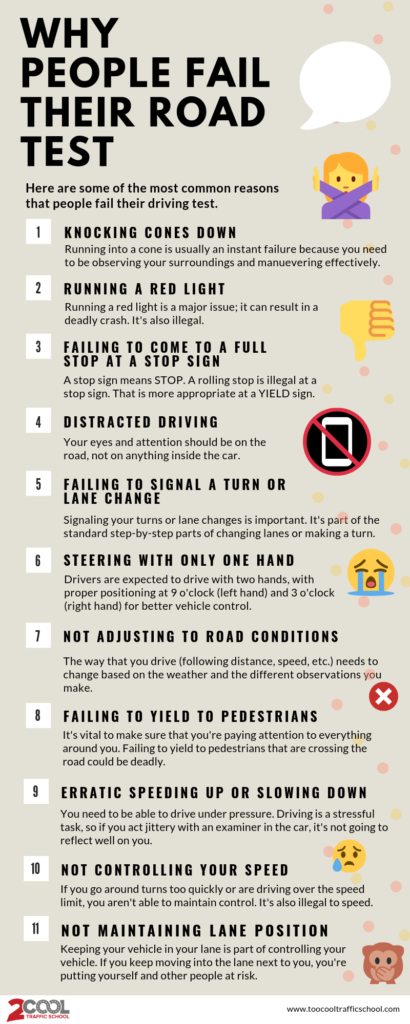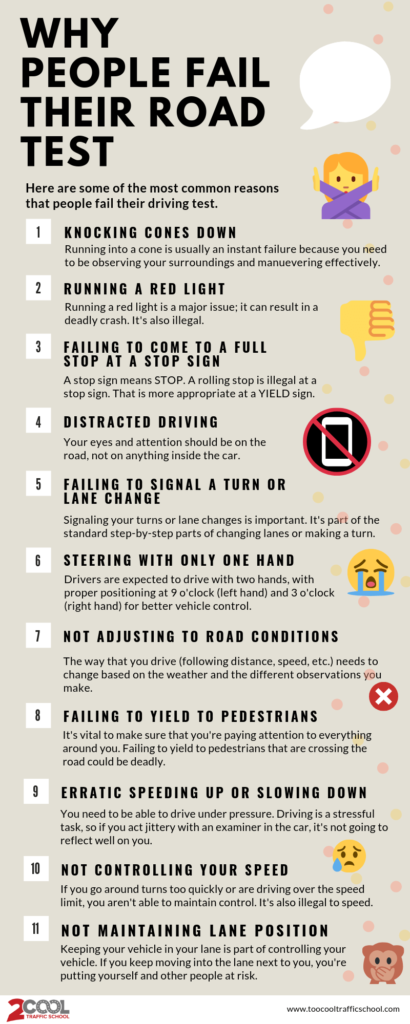Picture this: it’s your driving test day, nerves are riding high, and you feel confident about your preparation. Statistics show that every year, over 50% of applicants fail their driving test. This begs the question, what could be the number one cause of such high failure rates?
One major factor contributing to driving test failures is inadequate observation and awareness on the road. Candidates often fail to properly check mirrors, blindly relying on past experiences rather than staying vigilant. With heightened awareness and consistent practice, the chances of succeeding the test significantly increase.

What is the no. 1 reason for failing a driving test?
The number one reason for failing a driving test is poor observation skills. This includes not checking mirrors frequently, failing to notice road signs, and not observing other road users. Often, nervousness can lead to such oversights. However, good observation skills are crucial for safe driving. Keeping track of your surroundings allows you to react promptly to any potential hazards.
Examiners often see candidates fail to look over their shoulder when changing lanes. This blind spot check is critical, yet many overlook it. Such small mistakes can result in automatic failure. Furthermore, failing to observe pedestrian crossings can also lead to significant penalties. Awareness is key to passing the test successfully.
Improving observation skills requires practice and focus. Spend time on quiet roads to get used to checking your mirrors regularly. Practicing in different traffic conditions can also help you stay alert. Staying calm and focused can improve your chances of passing. Remember, good observation is a habit that can be developed over time.
Common observation mistakes during a driving test include not recognizing speed limits and ignoring cyclists or motorcyclists. These behaviors show a lack of awareness and can be dangerous. Always scan the road and surroundings actively. This practice not only helps in passing the test but also ensures safer driving in the long run. To sum up, effective observation is the cornerstone of driving safely and passing the test.
Lack of Observation: The Crucial Element in Test Failures
Failing to observe is a leading cause of driving test failures. Many candidates overlook the importance of scanning the road ahead and checking their mirrors. This can lead to missing critical information, like road signs or sudden changes in traffic. Frequently, lack of observation results in dangerous situations. This makes it a key focus area for examiners.
Effective observation means constantly being aware of your surroundings. For instance, drivers should regularly check their mirrors and blind spots. Yet, during tests, nerves often cause candidates to forget these vital steps. It’s essential to practice these habits consistently. Over time, they will become second nature.
Poor observation isn’t just about missing a glance over the shoulder. It also involves failing to anticipate potential hazards. Observing pedestrians, cyclists, and other vehicles requires constant vigilance. Remembering to look out for these elements can make a big difference. Awareness helps in responding to unexpected situations promptly.
To boost observation skills, candidates can focus on specific exercises during practice. These include checking mirrors every few seconds and making a mental note of road signs. Driving instructors often emphasize these points. Implementing these habits can improve test performance and overall driving safety. So, developing good observation skills is indispensable for any aspiring driver.
Impact of Poor Observation on Driving Test Outcomes
Poor observation skills during a driving test can drastically affect the outcome. When a candidate fails to check mirrors or blind spots, they miss crucial information about their surroundings. This can lead to dangerous situations like not seeing other cars or pedestrians. As a result, examiners will mark these lapses heavily. Such errors often lead to an immediate fail.
The impact of poor observation isn’t limited to immediate failures. It also influences the overall driving performance. For instance, missing a stop sign or failing to yield correctly can show a lack of readiness. These mistakes suggest that the driver is not fully prepared for real-world driving. Examiners want to ensure that drivers can handle various traffic scenarios safely. Thus, thorough observation is essential for a passing grade.
Another significant impact is the loss of confidence. When test-takers realize they missed important cues, it can rattle their nerves. This anxiety can lead to further mistakes. It’s a cycle that makes it hard to recover during the test. Maintaining good observation helps in keeping a calm and focused mindset.
Incorporating consistent observation practices can greatly improve test outcomes. Regularly checking mirrors and scanning for hazards becomes easier with practice. Instructors recommend these habits for a reason. They help in building a strong foundation for driving safely. Ultimately, good observation skills lead to higher chances of passing the driving test.
Skills Essential for Passing the Driving Test
One of the most critical skills for passing the driving test is proper observation. This means regularly checking mirrors, watching for pedestrians, and staying aware of other vehicles. Good observation helps you anticipate potential hazards. This skill can make a big difference in your test results. It’s vital to practice observation every time you drive.
Another essential skill is smooth and controlled vehicle handling. This includes maintaining control at various speeds, steering smoothly, and properly operating the clutch and gears if driving a manual car. Good vehicle control demonstrates confidence and competence. It makes the examiner feel you can handle different driving situations. This skill requires consistent practice to perfect.
Proper signaling and following road rules are also crucial. This involves using indicators when turning, stopping at stop signs, and obeying speed limits. Following these rules shows that you understand traffic laws. It also ensures the safety of yourself and others. Examiners pay close attention to how well you obey traffic signals and signs.
Mastering parking techniques is equally important. This includes parallel parking, reverse parking, and parking on a slope. Successfully demonstrating these skills shows that you can handle parking in various settings. Parking can be challenging, but practice can make it easier. Examiners often test these skills to ensure comprehensive driving ability.
Confidence and composure under pressure are essential for passing the driving test. Staying calm helps you make better decisions and avoid mistakes. Nervousness can lead to errors, so it’s important to manage it. Techniques like deep breathing can help you stay relaxed. A calm driver is seen as a capable driver by an examiner.
Tips on Improving Observation for Aspiring Drivers
One of the best ways to improve observation is by making a habit of regularly checking your mirrors. This means rearview and side mirrors every 5 to 8 seconds. This habit helps you stay aware of your surroundings. Practice it both during your lessons and in regular driving. Soon, it will become second nature.
Another useful tip is to always scan ahead for potential hazards. Look at least 15 seconds down the road to anticipate actions you need to take. Noticing things like brake lights, pedestrians, or obstacles early gives you more time to react. This proactive approach can help you feel more in control. It’s especially handy in heavy traffic situations.
Blind spot checks are crucial, especially when changing lanes. Make it a point to look over your shoulder before making these maneuvers. This can prevent accidents and ensures you’re fully aware of nearby vehicles. Practicing this regularly builds a good habit. It’s a small step that makes a big difference.
Practicing in various traffic conditions can also boost your skills. Drive during different times of the day, and in different weather conditions. This helps you get accustomed to different scenarios. Varying your practice can teach you to adapt quickly. Adaptability is a key trait for safe driving.
Listening to feedback from your instructor is invaluable. Pay attention to the points they emphasize about observation. They have the experience and know what examiners look for. Take their advice seriously and incorporate it into your driving. Their guidance can greatly improve your observation skills.
Common Mistakes to Avoid During a Driving Test
One of the common mistakes during a driving test is rolling through stop signs. Many candidates slow down but don’t come to a complete stop. This mistake can lead to immediate failure. Always remember to stop fully at stop signs. It shows you follow traffic rules.
Another frequent error is improper lane changing. Candidates often forget to signal or check their blind spots. This can be dangerous and is closely watched by examiners. Make sure to indicate your intentions and glance over your shoulder. Practicing this can help avoid mistakes.
Nervous mistakes like stalling the car can also occur. This is especially common with manual transmissions. If it happens, stay calm and restart smoothly. Panicking can make the situation worse. Confidence and composure are key.
Ignoring speed limits is another critical error. Driving too fast or too slow can indicate poor control and lack of awareness. Pay close attention to speed signs. Keeping your speed steady and appropriate for the road conditions is important.
Lastly, not observing pedestrian crossings can be a major mistake. Failing to yield to pedestrians is both dangerous and a serious fault. Always be on the lookout for people crossing the road. This shows you are mindful of all road users.
Conclusion
In summary, observation skills are essential for passing the driving test. Poor observation is the leading cause of failures. Focusing on these skills can significantly improve test outcomes. Practicing regularly and listening to feedback is key.
Understanding common mistakes and how to avoid them is equally important. Staying calm, following traffic rules, and being aware of surroundings are crucial components. These practices not only help in passing the test but in becoming a safe driver. Consistent effort and vigilance make all the difference.

